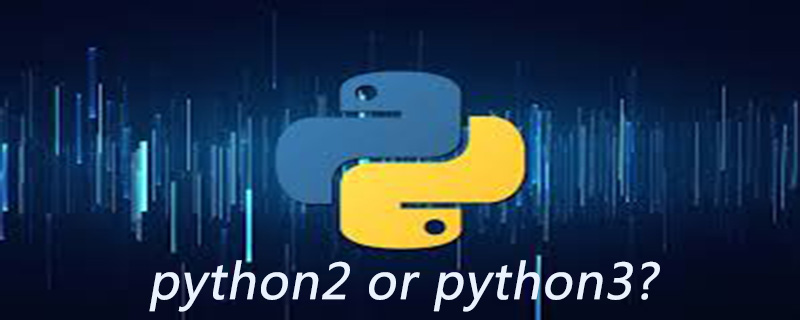現在學python該學python2還是python3?
python現在該學哪個版本? python2還是python3?
相關推薦:《python影片》

#對於剛開始學習Python的人來說,應該直接學習3系列版本,因為按照Python的發展規劃,未來將不再支援2系列版本,目前Python也正處在版本轉換的過程中,但是由於2系列版本有廣泛的應用和大量的歷史遺留項目,所以Python的版本切換計劃也不順利(一再延後)。當然,對於Python來說,溫和的版本切換政策是正確的,否則有可能會帶來大量的相容性問題。
Python語言雖然在近幾年得到了廣泛的關注,而且上升趨勢明顯,但是Python語言本身並不是一門新興的程式語言,Python與Java是同一時期面世的程式語言,只不過Java語言“年少成名”,而Python語言則屬於“大器晚成”。 Python語言早期主要應用於Web開發領域,但由於PHP和Java的原因,Python並沒有得到廣泛的重視。
隨著大數據和人工智慧的發展,Python語言的優勢才得到了體現,這也是Python得到廣泛關注和使用的重要原因,所以當前Python比較熱門的方向就集中在大數據(分析)和人工智慧相關方向(機器學習、自然語言處理、電腦視覺)。
機器學習方向是目前比較熱門的方向,而且採用Python來完成演算法實作是比較方便的,所以開發人員更願意採用Python。機器學習同時也是大數據分析的重要方式之一(另一種是統計方式),所以目前機器學習的落地應用也比較多。我在早期從事機器學習開發的時候一直在使用Java語言,後來改用Python之後確實要更方便。
除了大數據和人工智慧方向之外,目前Python在嵌入式領域也有一定的應用,隨著物聯網的發展,嵌入式開發的發展前景也比較廣闊。
python2和python3的區別
除了引入import from future,了解兩者的差異也是必要的
print函數:(Python3中print為函數,必須用括號括起來;Python2中print為class)
Python 2 的print 宣告已經被print() 函數取代了,這意味著我們必須包裝我們想要印在小括號中的對象。
Python 2
print 'Python', python_version() print 'Hello, World!' print('Hello, World!') print "text", ; print 'print more text on the same line' run result: Python 2.7.6 Hello, World! Hello, World! text print more text on the same line
#Python 3
print('Python', python_version())
print('Hello, World!')
print("some text,", end="")
print(' print more text on the same line')
run result:
Python 3.4.1
Hello, World!
some text, print more text on the same line透過input()解析使用者的輸入:(Python3中input得到的為str;Python2的input的到的為int型,Python2的raw_input得到的為str型別)統一一下:Python3中用input,Python2中用row_input,都輸入為str
幸運的是,在Python 3 中已經解決了把使用者的輸入儲存為str 物件的問題。為了避免在 Python 2 中的讀取非字串類型的危險行為,我們不得不使用 raw_input() 來代替。
Python 2
Python 2.7.6
[GCC 4.0.1 (Apple Inc. build 5493)] on darwin
Type “ help”, “copyright”, “credits” or “license” for more information.
>>> my_input = input('enter a number: ') enter a number: 123 >>> type(my_input) <type 'int'> >>> my_input = raw_input('enter a number: ') enter a number: 123 >>> type(my_input) <type 'str'>
Python 3
Python 3.4.1
[GCC 4.2.1 (Apple Inc. build 5577)] on darwin
Type “help”, “copyright”, “credits” or “license” for more information.
>>> my_input = input('enter a number: ') enter a number: 123 >>> type(my_input) <class 'str'>
整除:(沒有太大影響)( Python3中/表示真除,%表示取餘,//表示地板除(結果取整);Python2中/表示根據除數被除數小數點位得到結果,//同樣表示地板除)統一一下:Python3中/表示真除,%表示取餘,//結果取整;Python2中帶上小數點/表示真除,%表示取餘,//結果取整
Python 2
print 'Python', python_version() print '3 / 2 =', 3 / 2 print '3 // 2 =', 3 // 2 print '3 / 2.0 =', 3 / 2.0 print '3 // 2.0 =', 3 // 2.0
run result :
Python 2.7.6
3 / 2 = 1 3 // 2 = 1 3 / 2.0 = 1.5 3 // 2.0 = 1.0
Python 3
print('Python', python_version()) print('3 / 2 =', 3 / 2) print('3 // 2 =', 3 // 2) print('3 / 2.0 =', 3 / 2.0) print('3 // 2.0 =', 3 // 2.0)
run result:
Python 3.4.1
3 / 2 = 1.5 3 // 2 = 1 3 / 2.0 = 1.5 3 // 2.0 = 1.0
xrange模組:
在Python 3 中,range() 是像xrange() 那樣實作以至於一個專門的xrange() 函數都不再存在(在Python 3 中xrange( ) 會拋出命名異常)。
在 Python 2 中 xrange() 建立迭代物件的用法是非常流行的。例如: for 迴圈或是列表/集合/字典推導式。
這個表現十分像生成器(例如。「惰性求值」)。但這個 xrange-iterable 是無窮的,代表你可以無限遍歷。
由於它的惰性求值,如果你不得只遍歷它一次,xrange() 函數 比 range() 更快(例如 for 迴圈)。儘管如此,對比迭代一次,不建議你重複迭代多次,因為生成器每次都從頭開始。
python 2.4 與python 3.0 的比較
一、 print 從語句變成函數
原: print 1, 2 3
改為: print ( 1, 2 3 )
二、range 與xrange
原: range( 0, 4 ) 結果為清單[0,1,2,3 ]
改變為:list( range(0,4) )
原: xrange( 0, 4 ) 適用於for 迴圈的變數控制
改为:range(0,4)
三、字符串
原: 字符串以 8-bit 字符串存储
改为: 字符串以 16-bit Unicode 字符串存储
四、try except 语句的变化
原:
try:
......
except Exception, e :
......改为
try:
......
except Exception as e :
......五、打开文件
原: file( ..... )
或 open(.....)
改为:
只能用 open(.....)
六、从键盘录入一个字符串
原: raw_input( "提示信息" )
改为: input( "提示信息" )
七、bytes 数据类型
A bytes object is an immutable array. The items are 8-bit bytes, represented by integers in the range 0 <= x < 256.
bytes 可以看成是“字节数组”对象,每个元素是 8-bit 的字节,取值范围 0~255。
由于在 python 3.0中字符串以 unicode 编码存储,当写入二进制文件时,字符串无法直接写入(或读取),必须以某种方式的编码为字节序列后,方可写入。
(一)字符串编码(encode) 为 bytes
例: s = "张三abc12"
b = s.encode( 编码方式)
# b 就是 bytes 类型的数据
# 常用的编码方式为 : "uft-16" , "utf-8", "gbk", "gb2312", "ascii" , "latin1" 等
# 注 : 当字符串不能编码为指定的“编码方式”时,会引发异常
(二) bytes 解码(decode)为字符串
s = "张三abc12"
b = s.encode( "gbk") # 字符串 s 编码为 gbk 格式的字节序列
s1 = b.decode("gbk") # 将字节序列 b以gbk格式 解码为字符串
# 说明,当字节序列不能以指定的编码格式解码时会引发异常
(三)使用方法举例
#coding=gbk
f = open("c:\\1234.txt", "wb")
s = "张三李四abcd1234"
# -------------------------------
# 在 python2.4 中我们可以这样写:
# f.write( s )
# 但在 python 3.0中会引发异常
# -------------------------------
b = s.encode("gbk")
f.write( b )
f.close()
input("?")读取该文件的例子:
#coding=gbk
f = open("c:\\1234.txt", "rb")
f.seek(0,2) #定位至文件尾
n = f.tell() #读取文件的字节数
f.seek(0,0) #重新定位至文件开始处
b = f.read( n )
# ------------------------------
# 在 python 2.4 中 b 是字符串类型
# 要 python 3.0 中 b 是 bytes 类型
# 因此需要按指定的编码方式确码
# ------------------------------
s = b.decode("gbk")
print ( s )
# ------------------------------
# 在 python 2.4 中 可以写作 print s 或 print ( s )
# 要 python 3.0 中 必须写作 print ( s )
# ------------------------------
f.close()
input("?")运行后应显示:
张三李四abcd1234
(四) bytes序列,一但形成,其内容是不可变的
例:
s="ABCD"
b=s.encode("gbk")
print b[0] # 显示 65
b[0] = 66执行该句,出现异常: 'bytes' object does not support item assignment
八、 chr( K ) 与 ord( c )
python 2.4.2以前
chr( K ) 将编码K 转为字符,K的范围是 0 ~ 255
ord( c ) 取单个字符的编码, 返回值的范围: 0 ~ 255
python 3.0
chr( K ) 将编码K 转为字符,K的范围是 0 ~ 65535
ord( c ) 取单个字符的编码, 返回值的范围: 0 ~ 65535
九、 除法运算符
python 2.4.2以前
10/3 结果为 3
python 3.0
10 / 3 结果为 3.3333333333333335
10 // 3 结果为 3
十、字节数组对象 --- 新增
(一) 初始化
a = bytearray( 10 )
# a 是一个由十个字节组成的数组,其每个元素是一个字节,类型借用 int
# 此时,每个元素初始值为 0
(二) 字节数组 是可变的
a = bytearray( 10 ) a[0] = 25
# 可以用赋值语句更改其元素,但所赋的值必须在 0 ~ 255 之间
(三) 字节数组的切片仍是字节数组
(四) 字符串转化为字节数组
#coding=gbk
s ="你好"
b = s.encode( "gbk") # 先将字符串按某种“GBK”编码方式转化为 bytes
c = bytearray( b ) #再将 bytes 转化为 字节数组也可以写作
c = bytearray( "你好", "gbk")
(五) 字节数组转化为字符串
c = bytearray( 4 )
c[0] = 65 ; c[1]=66; c[2]= 67; c[3]= 68
s = c.decode( "gbk" )
print ( s )# 应显示: ABCD
(六) 字节数组可用于写入文本文件
#coding=gbk
f = open("c:\\1234.txt", "wb")
s = "张三李四abcd1234"
# -------------------------------
# 在 python2.4 中我们可以这样写:
# f.write( s )
# 但在 python 3.0中会引发异常
# -------------------------------
b = s.encode("gbk")
f.write( b )
c=bytearray( "王五","gbk")
f.write( c )
f.close()
input("?")以上是現在學python該學python2還是python3?的詳細內容。更多資訊請關注PHP中文網其他相關文章!

熱AI工具

Undresser.AI Undress
人工智慧驅動的應用程序,用於創建逼真的裸體照片

AI Clothes Remover
用於從照片中去除衣服的線上人工智慧工具。

Undress AI Tool
免費脫衣圖片

Clothoff.io
AI脫衣器

AI Hentai Generator
免費產生 AI 無盡。

熱門文章

熱工具

記事本++7.3.1
好用且免費的程式碼編輯器

SublimeText3漢化版
中文版,非常好用

禪工作室 13.0.1
強大的PHP整合開發環境

Dreamweaver CS6
視覺化網頁開發工具

SublimeText3 Mac版
神級程式碼編輯軟體(SublimeText3)

熱門話題
 如何解決Linux終端中查看Python版本時遇到的權限問題?
Apr 01, 2025 pm 05:09 PM
如何解決Linux終端中查看Python版本時遇到的權限問題?
Apr 01, 2025 pm 05:09 PM
Linux終端中查看Python版本時遇到權限問題的解決方法當你在Linux終端中嘗試查看Python的版本時,輸入python...
 如何在10小時內通過項目和問題驅動的方式教計算機小白編程基礎?
Apr 02, 2025 am 07:18 AM
如何在10小時內通過項目和問題驅動的方式教計算機小白編程基礎?
Apr 02, 2025 am 07:18 AM
如何在10小時內教計算機小白編程基礎?如果你只有10個小時來教計算機小白一些編程知識,你會選擇教些什麼�...
 在Python中如何高效地將一個DataFrame的整列複製到另一個結構不同的DataFrame中?
Apr 01, 2025 pm 11:15 PM
在Python中如何高效地將一個DataFrame的整列複製到另一個結構不同的DataFrame中?
Apr 01, 2025 pm 11:15 PM
在使用Python的pandas庫時,如何在兩個結構不同的DataFrame之間進行整列複製是一個常見的問題。假設我們有兩個Dat...
 如何在使用 Fiddler Everywhere 進行中間人讀取時避免被瀏覽器檢測到?
Apr 02, 2025 am 07:15 AM
如何在使用 Fiddler Everywhere 進行中間人讀取時避免被瀏覽器檢測到?
Apr 02, 2025 am 07:15 AM
使用FiddlerEverywhere進行中間人讀取時如何避免被檢測到當你使用FiddlerEverywhere...
 Uvicorn是如何在沒有serve_forever()的情況下持續監聽HTTP請求的?
Apr 01, 2025 pm 10:51 PM
Uvicorn是如何在沒有serve_forever()的情況下持續監聽HTTP請求的?
Apr 01, 2025 pm 10:51 PM
Uvicorn是如何持續監聽HTTP請求的? Uvicorn是一個基於ASGI的輕量級Web服務器,其核心功能之一便是監聽HTTP請求並進�...
 哪些流行的Python庫及其用途?
Mar 21, 2025 pm 06:46 PM
哪些流行的Python庫及其用途?
Mar 21, 2025 pm 06:46 PM
本文討論了諸如Numpy,Pandas,Matplotlib,Scikit-Learn,Tensorflow,Tensorflow,Django,Blask和請求等流行的Python庫,並詳細介紹了它們在科學計算,數據分析,可視化,機器學習,網絡開發和H中的用途
 Python中如何通過字符串動態創建對象並調用其方法?
Apr 01, 2025 pm 11:18 PM
Python中如何通過字符串動態創建對象並調用其方法?
Apr 01, 2025 pm 11:18 PM
在Python中,如何通過字符串動態創建對象並調用其方法?這是一個常見的編程需求,尤其在需要根據配置或運行...







